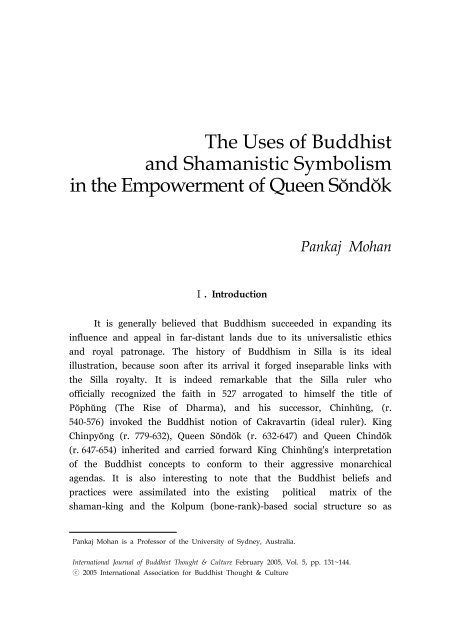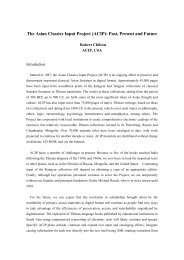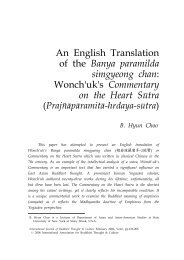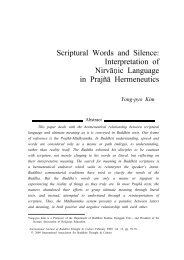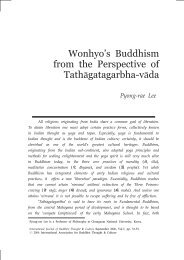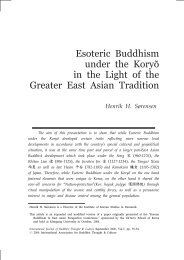You also want an ePaper? Increase the reach of your titles
YUMPU automatically turns print PDFs into web optimized ePapers that Google loves.
The Uses of Buddhist<br />
and Shamanistic Symbolism<br />
in the Empowerment of Queen Sŏndŏk<br />
<strong>Pankaj</strong> <strong>Moha</strong>n<br />
6<br />
Ⅰ. Introduction<br />
It is generally believed that <strong>Buddhism</strong> succeeded in expanding its<br />
influence and appeal in far-distant lands due to its universalistic ethics<br />
and royal patronage. The history of <strong>Buddhism</strong> in Silla is its ideal<br />
illustration, because soon after its arrival it f<strong>org</strong>ed inseparable links with<br />
the Silla royalty. It is indeed remarkable that the Silla ruler who<br />
officially recognized the faith in 527 arrogated to himself the title of<br />
Pŏphŭng (The Rise of Dharma), and his successor, Chinhŭng, (r.<br />
540-576) invoked the Buddhist notion of Cakravartin (ideal ruler). King<br />
Chinpyŏng (r. 779-632), Queen Sŏndŏk (r. 632-647) and Queen Chindŏk<br />
(r. 647-654) inherited and carried forward King Chinhŭng's interpretation<br />
of the Buddhist concepts to conform to their aggressive monarchical<br />
agendas. It is also interesting to note that the Buddhist beliefs and<br />
practices were assimilated into the existing political matrix of the<br />
shaman-king and the Kolpum (bone-rank)-based social structure so as<br />
<strong>Pankaj</strong> <strong>Moha</strong>n is a Professor of the University of Sydney, Australia.<br />
International Journal of Buddhist Thought & Culture February 2005, Vol. 5, pp. 131~144.<br />
c 2005 International Association for Buddhist Thought & Culture
132<br />
<strong>Pankaj</strong> <strong>Moha</strong>n : The Uses of Buddhist and Shamanistic Symbolism<br />
to maintain continuity and consistency with the unique Sillan tradition.<br />
In this paper I wish to take the monarchical practice of Queen<br />
Sŏndŏk for discussion and attempt to suggest that although she relied<br />
heavily on the versatile repertoire of Buddhist symbolism in order to<br />
legitimise her political imagination, she did not completely ignore the<br />
existing resources of Shamanism. Indeed, she drew on a diverse source<br />
of legitimatory symbolism, and her Buddhist policies were also adjusted<br />
to some extent to suit the indigenous values and tastes. This paper is,<br />
therefore a critique of the extant scholarship on early Korean<br />
<strong>Buddhism</strong> which generally describes early Silla rulers as devout<br />
Buddhists, and the entire trajectory of Korean <strong>Buddhism</strong> as an<br />
expression of the "nation-protecting" spirit, and thus ignores the<br />
important aspect of the syncretic religious symbolism used by the Silla<br />
royalty.<br />
Ⅱ. The Employment of Buddhist Symbolism<br />
by the Early Silla Royalty<br />
It has already been suggested that Silla rulers of the sixth and<br />
early seventh centuries sought to appropriate the spiritual significance of<br />
<strong>Buddhism</strong> by establishing close proximity to the Buddha, Buddhist<br />
deities and Buddhist monks. King Chipyŏng sought to establish his<br />
identity with the Buddha by assuming the title of Paekchŏng<br />
(translation of Suddodhana in Chinese, the other Chinese rendering of<br />
the name being Chŏngban) and calling his wife Maya puin (Maya Devi).<br />
<strong>Buddhism</strong> also became significant during the period as an instrument of<br />
diplomacy with the powerful Sui and Tang dynasties. However, in order<br />
to form a balanced perspective of this important theme in early Korean<br />
history, it is important to refer briefly to of the political reality of Silla<br />
in the late sixth and early seventh century. This historical context will<br />
also enable us to properly understand such related issues as the<br />
political roles of the monks Wŏngwang and Chajang, the creation of the<br />
distinct royal lineage of Sŏnggol (Sage Bone) for the ruling family, the<br />
establishment of the Nine-Storied Pagoda and the position of<br />
shamanism vis á vis <strong>Buddhism</strong>.
International Journal of Buddhist Thought & Culture 133<br />
The ascension of King Chinpyŏng stabilised the political situation,<br />
but resentment of some disgruntled aristocratic officials against<br />
increasingly institutionalised monarchical power continued to simmer.<br />
The hostility of the aristocracy manifested itself in a conspiracy against<br />
the throne hatched by Yichan Chilsuk and Achan Sŏkpum. The plot was<br />
revealed in 631, and Chilsuk's entire family and relatives to the ninth<br />
degree were executed. A glimpse of conflict between the royalty and the<br />
aristocracy is also given in the biography of Kim Hu-jik who headed<br />
the Ministry of Military Affairs during the reign of King Chinpyong<br />
(Samguk sagi 45, yŏljŏn, Kim Hu-jik, 420). 1<br />
The end of the Sŏngol (Sage Bone) male line after the death of<br />
King Chinpyŏng created a further crisis. Influential members of the<br />
Chingol could now legitimately hope to ascend the throne. Queen<br />
Sŏndŏk, daughter of King Chinpyŏng and a female member of the<br />
Sŏngol line, was installed on the throne but resentment against her rule<br />
surfaced in the form of Pidam's rebellion. Pidam had been sangdaedŭng<br />
for two years before he decided to launch a rebellion against what he<br />
believed to be the impropriety of a woman assuming power. According<br />
to the Samguk sagi:<br />
In the Sixteenth year of Queen Sŏndŏk, also the first year of<br />
Queen Chindŏk(647), the Ministers Pidam and Yŏmjŏng declared<br />
that a female ruler could not govern a state well. They raised<br />
their forces and wanted to overthrow her. The queen confined<br />
herself to the palace. Pidam and his forces stationed themselves<br />
at the Myŏnghwalsŏng, while the government forces were<br />
deployed at Wŏlsŏng (Samguk sagi 41, yŏljŏn, Kim Yu-sin chŏn,<br />
396).<br />
chong Chung-hwan has suggested that in his attempt to force<br />
Queen Sŏndŏk to abdicate, Pidam was representing the interests of the<br />
old guard of the Silla aristocracy and his rebellion brought into sharp<br />
focus the fundamental dichotomy between the two rival factions into<br />
which the aristocracy was now sharply divided (Chong, Chung-huan,<br />
1 Also see its discussion in Yi Myong-sik, "Silla chunggogi-ŭi wanggwŏn kanghwa kwajŏng", Yoksa<br />
kyoyuk nonjib, 113-14, (1990), p. 327.
134<br />
<strong>Pankaj</strong> <strong>Moha</strong>n : The Uses of Buddhist and Shamanistic Symbolism<br />
1977:26-27). Such officials as Kim Chun-chu, Kim So-Hyon and his son<br />
Kim Yu-sin who were loyal to the queen constituted the new faction<br />
within the aristocracy. The weakness of the old faction is evident in its<br />
complete inability to influence the course of contemporary politics.<br />
Despite their loud slogan of "a female ruler cannot govern well", the<br />
new aristocratic faction succeeded in installing yet another female<br />
member of the royalty on the throne. Chong's hypothesis of a divided<br />
aristocracy and bitter struggle for political supremacy by rival groups<br />
seems to be correct, but other historians have correctly reminded us<br />
that the spark of resentment against the administration of Queen<br />
Sŏndŏk was fanned when Emperor Taizong of the Tang expressed a<br />
similar view. Several years earlier the Chinese Emperor had said that<br />
Silla faced severe military threats from its neighbours because it was<br />
under a woman ruler who was quite naturally perceived to lack<br />
assertiveness and strength (Chu, Po-don, 1979:209-211).<br />
Ⅲ. The Political Imperatives<br />
The reigns of these three rulers were also characterised by intense<br />
conflicts with Koguryŏ and Paekche. An increasingly stronger<br />
Paekche-Yamato solidarity and a growing political understanding<br />
between Koguryŏ and Yamato further aggravated the political crisis of<br />
Silla. The unification of China under the Sui had changed the balance<br />
of power in East Asia, and the impact of change in China was most<br />
acutely felt on the Korean peninsula. Koguryŏ started diversifying its<br />
political and diplomatic linkages by sending monks and technicians to<br />
Yamato. Yamato in return attempted to apply pressure on Silla (Joseph<br />
Wong, 1984:24-28). The Nihon shoki records that in 591 Yamato<br />
dispatched over 20,000 troops across the strait to Tsukushi (ie. Hakata<br />
in Northern Kyushu), and that they remained there for four years. The<br />
Nihon shoki refers to yet another Yamato military expedition to Silla in<br />
600 which, it claims, resulted in the former occupying six Silla castles.<br />
While a recent work takes the record at its face value (Pan Yihong,<br />
1997:124), Joseph Wong in his well-researched doctoral dissertation
International Journal of Buddhist Thought & Culture 135<br />
underlines the flawed character of Silla-related accounts of the Nihon<br />
shoki and points out that the claim of an easy, albeit temporary, seizure<br />
of Silla castles in 600 is "wrongly dated" or "a complete fabrication." (Joseph<br />
Wong, 1984:27). The biased nature of the accounts of the Nihon shoki<br />
notwithstanding, it is very likely that Yamato dispatched its warships<br />
across the strait in order to intimidate Silla and thereby cement its ties<br />
with its new ally, Koguryŏ.<br />
During this period (spanning the reigns of King Chinpyŏng, Queen<br />
Sŏndŏk and Queen Chindŏk) Koguryŏ and Paekche launched increasingly<br />
aggressive campaigns against Silla. In the last three decades of the sixth<br />
century, Silla enjoyed a relatively peaceful border with Koguryŏ. In 603,<br />
however, Koguryŏ renewed its hostility against Silla. In 608 Koguryŏ<br />
launched a more sustained attack, resulting in the death of 8,000 Sillans<br />
and the capture of one Silla castle. Silla faced Koguryŏ invasion again<br />
in the seventh year of Queen Sŏndŏk (638). While the Samguk sagi<br />
portrays Silla generally as a victim of Koguryŏ's military ambition, the<br />
battle of 629 has been shown to be initiated by Silla. In this battle<br />
Koguryŏ lost the fort of Nyang along with more than five thousand<br />
souls.<br />
As regards Paekche, perhaps, due to its crippling defeat in the<br />
battles with Silla during the reign of King Chinhŭng, it did not make<br />
any incursions across the Silla border for about half a century.<br />
However, it reopened its hostility in the seventh century. It fought<br />
small-scale battles with Silla in 611 and 618. Subsequent battles between<br />
Silla and Paekche forces were fought in 624, 626, 627, 633, 636, and 642<br />
with disastrous consequences for Silla. In 643, however, the tide turned<br />
against Paekche when the Silla army under the command of General<br />
Kim Yu-sin captured seven Paekche forts (Samguk sagi, Kim Yu-sin<br />
chŏn, p. 397). The two kingdoms continued to fight sporadic battles<br />
until 663 when the joint Silla-Tang forces erased Paekche from the map<br />
of the peninsula.<br />
The Silla court attempted to meet these challenges by expanding<br />
coercive power and bureaucratic apparatus. Elaborate officialdom and<br />
rich military resources are doubtless essential constituents of a centralised
136<br />
<strong>Pankaj</strong> <strong>Moha</strong>n : The Uses of Buddhist and Shamanistic Symbolism<br />
state, but these features are insufficient per se in confirming and<br />
consolidating monarchical authority. The ruling strata needs to justify its<br />
authority and the rules of heredity and hierarchy governing access and<br />
exclusion to the key resources of the state within the framework of<br />
shared beliefs and ideology. A framework of common ideology and<br />
system of belief provides moral sanction to the authority of the ruling<br />
elite over the subordinate class (David Beetham, 1991:69-70).<br />
Ⅳ. The Channelisation of the Wisdom of Monk Chajang<br />
Monk Chajang, one of the most distinguished leaders of early<br />
Silla <strong>Buddhism</strong> and the patriarch of the Buddhist chruch during the<br />
reign of Queen Sŏndŏk, advised the Queen to build a nine-story pagoda<br />
at the Hwangnyong temple, supposedly as a symbolic conquest over the<br />
nine contiguous states, including China and Japan (Samguk yusa 3,<br />
Hwangnyongsa kuchŭng tap, 139). 2 Iryŏn's grandiose interpretation<br />
seems to be less credible than the near contemporary Hwangnyong sa<br />
kuchŭng moktap chalju ki (Record [inscribed on a Pillar] of the<br />
Nine-storied Wooden Stupa of the Hwangnyong Temple) which<br />
attributes the idea to Dhyana Master Yuanxiang of Nansan who is<br />
believed to have said (to Chajang), "If a nine-storied stupa is<br />
constructed in (the precincts of) the Hwangnyong Monastery in your<br />
country, the entire Haedong (East of the Sea, a term representing the<br />
Korean peninsula) will surrender to your kingdom (Hwang, Su-yong,<br />
1997:168-175). 3 Chajang is also credited with having proclaimed that the<br />
contemporary ruler of Silla belonged to the Ksatriya caste, the warrior<br />
caste of India to which Buddha himself belonged. In an age of great<br />
internal turmoil and external threat, employment of Buddhist elements<br />
to further enhance the sanctity and sacredness of Queen Sŏndŏk's<br />
lineage by tracing it to the clan of Buddha had an obvious political<br />
dimension.<br />
It is also recorded in the Chinese text that Xù gāosēng zhuàn at<br />
2 The expression "ku Han" used in the text usually means "all the Han people, or people on<br />
the Korean peninsula". In ancient Chinese usage Nine implied the concept of totality.<br />
3 For the original Chinese text of the Record see pages 172-175.
International Journal of Buddhist Thought & Culture 137<br />
the advice of Chajang Queen Sŏndŏk effected a change in Silla's dress<br />
code to conform to the Chinese standard. Kim Jong-Myung argues that<br />
the account of the Samguk sagi which credits Kim Chun-chu (who later<br />
ruled as King Muyŏl) for the change of Silla's official dress to the<br />
Chinese model is more credible. The relevant account of the Samguk<br />
sagi is in agreement with the Chinese sources, the Jiu Tang shu, the Xin<br />
Tang shu and the Zizhi tongjian, which state that during his audience<br />
with Emperor Taizong in 648, Kim Chun-chu requested that Silla be<br />
allowed to change its official dress so as to accord with the Tang<br />
system, whereupon the emperor had precious clothes brought out from<br />
the palace and presented to him. 4<br />
As has been suggested earlier, compilation of the Samguk sagi was<br />
governed by Kim Pu-sik's Confucian values, and his omission of<br />
materials on <strong>Buddhism</strong> was a deliberate strategy to undermine the role<br />
of <strong>Buddhism</strong> in early state-formation. One may illustrate this point by<br />
pointing out that despite the evident significance of Chajang in the<br />
political history of seventh century Silla, Kim Pu-sik recorded only three<br />
facts about him, and mostly "sinocentric facts" at that―his journey to<br />
China in the fifth year of Queen Sŏndŏk, his return from China in the<br />
twelfth year and finally, the construction of the stupa at the<br />
Hwangnyong monastery on his advice. Therefore, official as it may be,<br />
Samguk sagi has to be subjected to the same scrutiny and scepticism as<br />
records affiliated with <strong>Buddhism</strong>. First let's see what Xù gāosēng zhuàn<br />
(the source with which Iryŏn accords and on which he doubtless drew<br />
for his data) has to say about Chajang's role in the Sinicisation of Silla<br />
institutions:<br />
".... There were differences between the Chinese and<br />
barbarians in customs and clothing. Chajang revered only the<br />
true tradition. How could his loyalty be divided? After this<br />
matter (Chajang's proposal) was discussed (at court), Silla<br />
4 Samguk sagi 5, Silla pongi Chindŏkwang, Ibid 33 Chapji 2.pp. 50-51<br />
Xin Tangshu 10, Fac. 220, (Dongyi zhuan, Xinluo) p. 6203 op cit<br />
An English translation of the Samguk sagi'stext about Kim Chun-chu's mission to the court of<br />
Taizong is given in John Jamieson, The Samguk sagi and the Unification Wars. Unpublished Ph.D<br />
thesis, University of California, Berkeley, 1969, pp. 38-39.
138<br />
<strong>Pankaj</strong> <strong>Moha</strong>n : The Uses of Buddhist and Shamanistic Symbolism<br />
changed its frontier clothing and took Tang norms as standard"<br />
(Xù gāosēng zhuàn( 續 高 僧 傳 ), 24, in Taisho 50).<br />
These two records of Samguk sagi and Samguk yusa, corroborated<br />
by Chinese Confucian and Buddhist records respectively, are neither<br />
mutually exclusive nor dichotomous. The Buddhist records state that<br />
soon after Chajang returned from Tang China, he proposed to the Silla<br />
court to standardise ideas and political institutions of the state in<br />
conformity with the Chinese ones, and that his proposal was endorsed.<br />
However, Silla still needed to follow the standard procedure of<br />
forwarding its petition through a proper diplomatic channel and<br />
receiving the approval of the Tang emperor. The Silla court entrusted<br />
this task to Kim Chun-chu, noted for his "diplomatic savoir-faire" (John<br />
Jamieson, 1969:38). No doubt Chajang was merely an adviser to the<br />
court and Kim Chun-chu a pivotal figure in the word of diplomacy and<br />
politics. His contribution far outweighed the role of Chajang in the<br />
Sinicisation of Silla's traditions and institutions. Kim Chun-chu's seminal<br />
significance in this respect is evident from another work Nihon sheki,<br />
written by a Koguryŏ monk, Tohyŏn. Though it is now lost, Nihon<br />
shoki has preserved the relevant text. Aston's translation does not bring<br />
out the real meaning of the passage: "Chhyun-chhyu-chi, of Silla.....<br />
Thereupon he again served Thang(sic), and, putting off the national<br />
garb, made a fawning appeal to the Son of Heaven, with the object of<br />
bringing disaster on a neighbouring kingdom." (p. 266). The text<br />
originally means that Kim Chun-chu of Silla undertook a diplomatic<br />
mission to Tang, discarded the native customs and codes of dress and<br />
caps, and grovellingly petitioned to the Son of Heaven to invade a<br />
neighbouring country (Koguryŏ). 5<br />
5 Nihon shoki Vol. 2, Fac. 26, Saimei. Aston's translation does not bring out the real meaning of<br />
the passage: "Chhyun-chhyu-chi, of Silla.....Thereupon he again served Thang(sic), and, putting<br />
off the national garb, made a fawning appeal to the Son of Heaven, with the object of<br />
bringing disaster on a neighbouring kingdom." (p. 266). The text originally means that Kim<br />
Chun-chu of Silla undertook a diplomatic mission to Tang, discarded the native customs and<br />
codes of dress and caps, and grovellingly petitioned to the Son of Heaven to invade a<br />
neighbouring country (Koguryŏ). For the original text see Nihon shoki, edited and annotated by<br />
Inoue Mitsusada, Tokyo: Chuo Koron, 1987, p. 256.
International Journal of Buddhist Thought & Culture 139<br />
Ⅴ. Manipulation of Shamanic Beliefs<br />
Even after a century of fervent patronage and propagation of<br />
<strong>Buddhism</strong> by the royalty, beliefs and practices centering on shamanism 6<br />
constituted a significant ritual system in early Silla. It has been<br />
suggested earlier that soon after its official recognition <strong>Buddhism</strong> started<br />
absorbing shamanic symbolism and performing many ritual functions<br />
that had hitherto been fulfilled by shamans. But <strong>Buddhism</strong> could not<br />
succeed in exercising complete control of the religious sensibility and<br />
beliefs of the Silla people. <strong>Buddhism</strong> and Shamanism had to share the<br />
sacred space. Notwithstanding their Sinocentric ideological orientation,<br />
Silla rulers of the late sixth and the first half of the seventh century<br />
could not afford to ignore the political significance that shamanic<br />
symbols held for them. It was the age when the spiritual message and<br />
moral precepts of <strong>Buddhism</strong> had yet to spread to the lower echelons of<br />
the Silla society. Shamanism still defined their world view. It is also<br />
significant to remember that the Silla rulers of this period sought to<br />
redress what they reckoned as a faultline in the traditional concept of<br />
statecraft―the intervention of the aristocratic group in the political<br />
process―and to establish a direct linkage with their subjects. Their<br />
strategies of political legitimation, therefore, embodied symbols which<br />
the common people recognised and held as sacred.<br />
King Chinpyŏng's repertoire of legitimatory instruments included a<br />
Jade Belt, reckoned as one of the Three Precious Treasures of Silla. 7<br />
And his successor, Queen Sŏndŏk's identification with shamanism is<br />
expressed in her reported ability to foresee future events. It conformed<br />
to the ancient Silla tradition of female shamans presiding over state<br />
rituals and communicating with the world of spirits. The Samguk yusa<br />
relates a story that one winter day a number of frogs were seen at<br />
Yongmyo temple by the Ongmun chi (Jade Gate Pond). When the<br />
6 It needs to be remembered that I have invested the word shamanism with a broader meaning<br />
than is usually attributed. All forms of indigenous belief, including animism, the autochtonous<br />
spirit cult, and magic have been subsumed under its rubric.<br />
7 Kim Sang-hyon has related invention of the so-called Three Jewels with the precarious political<br />
position of the Silla monarchy, particularly in the wake of overthrow of King Chinji. See his<br />
"Silla sambo-ŭi sŏngnip-kwa kŭ ŭiŭi", Tongguk sahak , 14 (1980).
140<br />
<strong>Pankaj</strong> <strong>Moha</strong>n : The Uses of Buddhist and Shamanistic Symbolism<br />
queen heard about it, she ordered her generals to rush to Yŏgŭn Kok<br />
("Women Root Valley") at the western outskirts of the capital with two<br />
thousand troops. Evidently, the queen interpreted this omen as a<br />
warning of an invasion by Paekche forces through the western frontier<br />
of the kingdom. Later she explained that the frogs at Ongmun chi gave<br />
her grounds to anticipate a Paekche invasion, because she took the<br />
mysterious appearance of the frogs to mean the sudden appearance of<br />
enemy soldiers. The name Ongmun chi or Jade Gate Pond led her to<br />
think of another place name resonant of human anatomy, and she came<br />
up with the answer, Yŏgun. 'Ongmun' as name of the pond also gave<br />
her a reason to imagine of the western frontier, because both women<br />
and the western direction have white as their colour symbols (Samguk<br />
yusa 1, Sŏndŏkwang chigi samsa, 58-59).<br />
Records about Queen Sŏndŏk in both the Samguk sagi and the<br />
Samguk yusa give an impression that she possessed great intelligence.<br />
According to an anecdote, Emperor Tang Taizong sent King Chinpyŏng<br />
peony seeds, accompanied by a painting of the flower. Sŏndŏk, who was<br />
seven at the time, looked at the painting and said that the flower<br />
would be beautiful, but would lack fragrance. She pointed to the<br />
painting which did not have bees and butterflies hovering around the<br />
flower. An index of intelligence or knowledge in traditional societies was<br />
the ability to anticipate future events. 8 The Jade Gate Pond story<br />
appears to be part of Silla's folklore, based on a popular belief in her<br />
considerable intellectual gift and aimed at justifying her "kingship" on<br />
the grounds of her supranormal, shamanic power.<br />
It is evident that though the Silla rulers borrowed Chinese ideas<br />
and institutions and appropriated myths and motifs of <strong>Buddhism</strong> for<br />
legitimatory functions, they were not oblivious to the meaning of<br />
indigenous symbols of power which the common people of Silla<br />
recognised and understood.<br />
8 Kang Chae-chŏl has argued that the tale was deliberately manufactured in order to shore up<br />
the monarchical authority of Queen Sŏndŏk. See his essay "Sŏndŏk yŏwang chigi sŏrhwa-ui<br />
yŏngu, Tongyanghak 21 (1991) pp. 77-79".
International Journal of Buddhist Thought & Culture 141<br />
Ⅵ. Conclusion<br />
It is apparent from the above discussion that Queen Sŏndŏk<br />
inherited and carried forward the tradition of King Chinhŭng and King<br />
Chinpyŏng by employing Buddhist rhetoric and rituals for the peace and<br />
prosperity of the kingdom. The period of her reign was marked by<br />
political tremors caused by latent tension between the royalty and<br />
aristocracy. The continued enhancement of monarchical power meant<br />
erosion of the traditional prerogatives of the aristocracy. She harnessed<br />
the knowledge and prestige of Monk Chajang to achieve secular<br />
objectives of the state and mould the national consciousness in the way<br />
that served monarchical interests. Chajang's role in construction of the<br />
Nine-story stupa illustrates this point. Chajang's political use of<br />
Buddhist rhetoric is also evident in his apotheosis of Queen Sŏndŏk as<br />
a ksatriya, a caste of valour and virtue in Buddhist literature.<br />
It is also important to note that Queen Sŏndŏk and Chindŏk's<br />
name Tŏkman and referred to specific personages in the Buddhist<br />
literature. The name Sŏndŏk represents a cakravarti and/or Buddhahood<br />
symbolism. Apparently, the unified cakravartin-Bodhisattva symbolism<br />
continued from King Chinhŭng down to Queen Chindŏk, although the<br />
forms in which they were manifested were different.<br />
Glossary<br />
Chajang 慈 藏<br />
Chindŏk yŏwang 眞 德 女 王 代 (Queen Chindŏk, 647‐654)<br />
Chingol 眞 骨 (True Bone)<br />
Chinhŭngwang 眞 興 王 (King Chinhŭng)<br />
Chinpyŏngwang 眞 平 王 (King Chinpyŏng)<br />
Chollyunsŏngwang 轉 輪 聖 王 (Cakravartin)<br />
Dào xuān 道 宣<br />
Dongyi chŏn 東 夷 傳 (An Account of the Eastern Barbarians)<br />
Haedong Kosŭng chŏn 海 東 高 僧 傳 (Biographies of Eminent Korean Monks)<br />
Hwangnyong sa 黃 龍 寺 ( 皇 龍 寺 (Yellow/ Imperial Dragon Temple)
142<br />
<strong>Pankaj</strong> <strong>Moha</strong>n : The Uses of Buddhist and Shamanistic Symbolism<br />
Hwangnyong sa kuchŭng moktap chaljuponki 黃 龍 寺 九 層 木 塔 刹 柱 本 紀<br />
(Record [inscribed on a Pillar] of the Nine‐storied<br />
Wooden Stupa of the Hwangnyong Temple)<br />
Iryŏn 一 然<br />
Jin Shu 晉 書<br />
Jiu Tang shu 舊 唐 書<br />
Kakhun 覺 訓<br />
Kim Ch'un‐ch'u 金 春 秋<br />
Kim Pu-sik 金 富 軾<br />
Kim Shu‐hyon 金 舒 玄<br />
Kim Yu‐sin 金 庾 信<br />
Koguryŏ 高 句 麗<br />
Kokpan 斛 飯 (Dronodana)<br />
Kolpum che 骨 品 制 (Bone rank system)<br />
Maya Puin 摩 耶 婦 人<br />
Nihon shoki 日 本 書 紀<br />
Ongmun chi 玉 門 池 (Jade Gate Pond)<br />
Paekche 百 濟<br />
Paekpan 伯 飯 (Shuklodana)<br />
Pitam 毗 曇<br />
Pŏphŭng wang 法 興 王 (King Pŏphŭng)<br />
Samguk sagi 三 國 史 記 (A History of Three Kingdoms)<br />
Samguk yusa 三 國 遺 事 (Memorabilia of Three Ancient Kingdoms)<br />
Silla 新 羅<br />
Sŏndŏk yŏwang 善 德 女 王 (Queen Sŏndŏk, 632‐647)<br />
Sŏnggol 聖 骨 (Sacred / Holy Bone)<br />
Tang 唐<br />
Tang Taizong 唐 太 宗<br />
Xin Tang shu 新 唐 書<br />
Xù gāosēng zhuàn 續 高 僧 傳<br />
Yŏgŭn Kok 女 根 谷 (Women Root Valley)<br />
Zizhi tongjian 資 治 通 鑑
International Journal of Buddhist Thought & Culture 143<br />
References<br />
Dào xuān. Gāo sēng zhuàn [40 juan] ( 高 僧 傳 ). Taipei: Taiwan yin<br />
jing chu fa xing, 1970.<br />
Fang, Xuanling, Jiu Tang shu : [130 juan] ( 舊 唐 書 ). Shanghai :<br />
Zhonghua shu ju, 1927-1936.<br />
Iryŏn , Samguk yusa ( 三 國 遺 事 ); edited by Ch'oe Nam-son [1927]<br />
Seoul : Somun munhwasa, 1999 (Reprint).<br />
Kakhun, Haedong Kosŭng chŏn ( 海 東 高 僧 傳 ) ; Translated into Korean<br />
by Yi Pyong-hun. Seoul : Uryu Munhwasa, 1975.<br />
Kakhun, Lives of Eminent Korean Monks; Translated with an introd.<br />
by Peter H. Lee. Cambridge, Harvard University Press, 1969.<br />
Kim, Pu-sik, Hwangnyong sa kuchŭng moktap chaljuponki<br />
黃 龍 寺 九 層 木 塔 刹 柱 本 紀 , Samguk sagi ( 三 國 史 記 ); edited by Yi<br />
Pyong-do edited. Seoul : Uryu Munhwasa, 1977.<br />
Nihongi ( 日 本 紀 ), chronicles of Japan from the earliest times to A.D. 697.<br />
Translated from the original Chinese and Japanese by W. G. Aston.<br />
London, Pub. for the Society by K. Paul, Trench, Trubner, 1896<br />
Nihon shoki ( 日 本 書 紀 ) edited and annotated by Inoue Mitsusada,<br />
Tokyo: Chuo Koron, 1987.<br />
Nihon shoki shichu ( 日 本 書 紀 史 注 ) Yamada Munemutsu, edited.<br />
Tokyo : Fujinsha, 1997-.<br />
Ouyang, Xiu, Xin Tang shu : [225 juan] ( 新 唐 書 ). Taipei : Taiwan<br />
shang wu yin shu guan, Taibei : Ding wen shu ju, Min guo 74<br />
[1985].<br />
The Digha Nikaya, edited by T.W. Rhys Davids and J. Estlin<br />
Carpenter. London : Pali Text Society ; London ; Boston :<br />
Distributed by Routledge & K. Paul, 1975-1982. English translation<br />
Dialogues of the Buddha. Translated from the Pali by T.W.R. Davids.<br />
London, 1899-1910.<br />
Xù gāosēng zhuàn ( 續 高 僧 傳 ) T. 50.<br />
Beetham, David<br />
1991<br />
Chong,<br />
Chung-huan<br />
1977<br />
The Legitimation of Power, Atlantic<br />
Highlands, NJ: Humanities Press<br />
International.<br />
"Pidam Yŏmjŏngnan-ui wonin ko," Tonga<br />
nonch'ong, 14, pp.26-27.
144<br />
<strong>Pankaj</strong> <strong>Moha</strong>n : The Uses of Buddhist and Shamanistic Symbolism<br />
Chu, Po-don<br />
1979<br />
Hwang, Su-Yong<br />
1997<br />
John, Jamieson<br />
1969<br />
Kang, Chae-chŏl<br />
1991<br />
Kim, Jong Myung<br />
1995<br />
Kim, Sang-hyon<br />
1980<br />
Liu, Tsun-Yan<br />
1984<br />
Pan, Yihong<br />
1997<br />
Raoul Birnbaum<br />
Wong, Joseph<br />
(Huang, Yueh-se)<br />
1984<br />
Yi, Myong-sik<br />
1990<br />
"Silla chunggo-ui chibang tongchi chojik-e<br />
taehayŏ", Hanguksa yŏngu, 23.<br />
Hwang Su-yong chonjib 5. Seoul: Toso<br />
ch'ulp'an Hyean. pp. 168- .<br />
The Samguk sagi and the Unification Wars.<br />
Unpublished PhD thesis, University of<br />
California, Berkeley.<br />
"Sŏndŏk yŏwang chigi sŏrhwa-ŭi yŏngu”,<br />
Tongyanghak 21. pp. 77-79.<br />
"Chajang and '<strong>Buddhism</strong> as a Protector of<br />
the Nation: A Reconsideration", in<br />
Religions in Traditional Korea, edited by<br />
Henrik H. Sorensen, Copenhagen: The<br />
Seminar for Buddhist Studies.<br />
"Silla sambo-ŭi sŏngnip-kwa kŭ ŭiŭi",<br />
Tongguk sahak, 14.<br />
"The Syncretism of the Three Teachings<br />
in Sung-Yüan China", in his New<br />
Excursions from the Hall of Harmonious<br />
Wind, Leiden: E. J. Brill.<br />
Son of Heaven and Heavenly Qaghan:<br />
Sui-Tang China and its Neighbours,<br />
Bellingham: Western Washington<br />
University, p. 124.<br />
Studies on the Mysteries of Manjusri: A<br />
Group of East Asian Mandalas and their<br />
Traditional Symbolism, Society for the<br />
Study of Chinese Religions Monograph,<br />
No. 2.<br />
"The Korean Wars and East Asia in the<br />
Seventh Century", Unpublished Ph.D.<br />
dissertation, Australian National<br />
University, Canberra.<br />
"Silla chunggogi-ŭi wanggwŏn kanghwa<br />
kwajŏng", Yŏksa kyoyuk nonjib, 13-14.


